Bulk emailing has been the marketing backbone for businesses of all shapes and sizes. It’s fast, scalable, and doesn’t drain your budget. But let’s face it: blanket emails tossed out like confetti at a parade just don’t cut it anymore.
Here’s the harsh truth: traditional bulk emailing often ends up with your carefully crafted message sitting in spam folders, ignored by uninterested audiences, or worse – dragging down your sender reputation. It’s like shouting into the void and hoping someone shouts back.
What if there was a better way? Instead of relying on the “spray-and-pray” approach, tools like Woodpecker empower you to create campaigns that are both personal and purposeful. Think less junk mail, more meaningful conversations. It’s bulk emailing, but with a sharp, strategic twist – and the results speak for themselves.
It’s time to stop filling inboxes and start filling pipelines. Ready to evolve your strategy?
What Are Bulk Emailing Services?
A bulk email marketing service is the trusty megaphone for businesses looking to reach large audiences with ease. It lets you send mass emails to a contact list—whether you’re sharing company announcements, launching marketing campaigns, or promoting your online store.
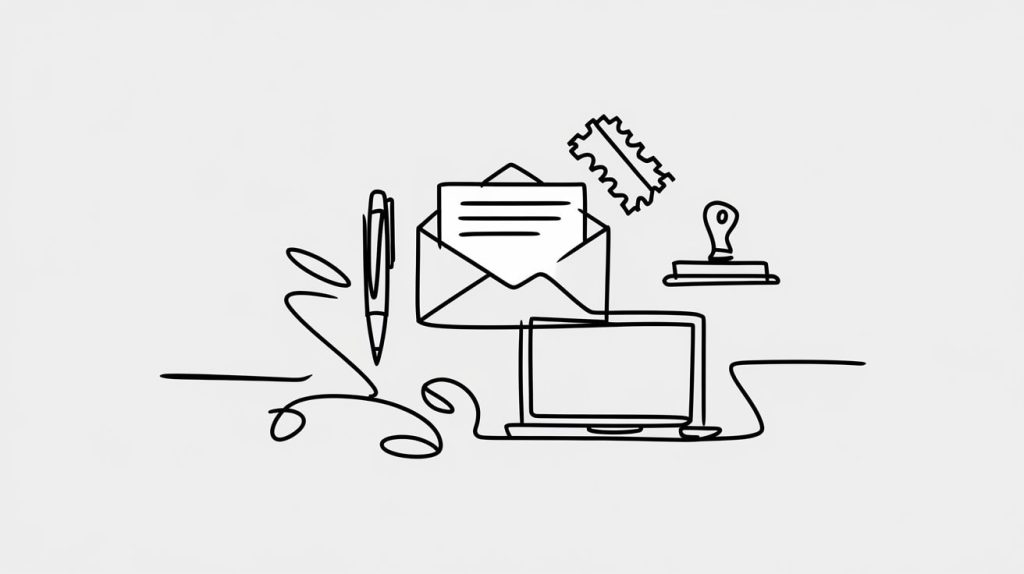
Think of it as your all-in-one solution to craft, deliver, and track marketing emails.
How Do Bulk Emailing Services Work?
Using a bulk email software, you can:
- Design engaging emails with customizable templates and a drag and drop builder.
- Segment recipients with advanced segmentation tools, ensuring personalized messaging.
- Monitor performance through real-time analytics, email tracking, and custom reports.
- Automate follow-ups and trigger-based email marketing campaigns with email automation and marketing automation tools.
This approach isn’t just about sending bulk emails for free or using a free bulk email service; it’s about maximizing impact while keeping an eye on email deliverability and anti-spam laws.
Typical Use Cases
Bulk email providers cater to a variety of needs:
- Newsletters: Keep your audience informed with engaging updates.
- Promotions: Drive sales through exclusive offers or deals.
- Announcements: Notify customers about new products, features, or events.
- Transactional Emails: Confirm purchases, send receipts, or update on delivery statuses.
- Signup Forms & Push Notifications: Engage and grow your subscription forms.
Traditional vs Modern Approaches
The classic method of sending mass email campaigns often relied on generic messages sent to unlimited contacts with little personalization. While free mass emails were appealing, they frequently fell short in terms of engagement and email delivery.
In contrast, modern bulk email marketing platforms focus on personalized, data-driven strategies. They leverage:
- User behavior tracking and purchase history to tailor content.
- Integrated tools like landing page builders, email APIs, and subject line generators for optimization.
- Features like b testing, advanced reporting features, and phone support for more advanced features.
- Add-ons like SMS marketing and push notifications for multichannel campaigns.
For example, a modern bulk email provider like Woodpecker blends the efficiency of bulk email senders with the precision of contact management and advanced segmentation, ensuring your emails are relevant and impactful.
Features to Look for in Bulk Emailing Services
Not all bulk email service providers are created equal.
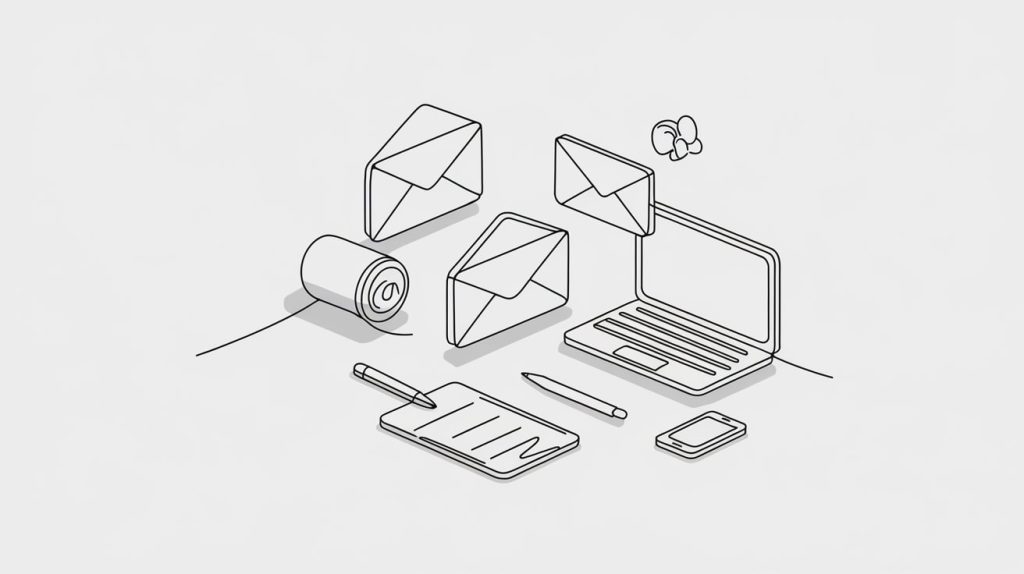
If you want your bulk email campaign to stand out, it’s essential to pick a platform that offers the right tools to help you connect with your audience, not just their inbox. Here’s what to look for:
1. Ease of Use: Keep It Simple with a Drag-and-Drop Editor
Creating stunning emails shouldn’t feel like rocket science. Look for platforms with a drag and drop editor and customizable email templates. Whether you’re designing for existing contacts or reaching out to new audiences, these tools make your life easier. Bonus points if the interface doesn’t make you want to throw your laptop out the window.
2. Personalization Tools: One Size Doesn’t Fit All
Your audience isn’t a monolith, so why treat them like one? Use a mass email service that offers dynamic content to tailor messages for each recipient. Personalization tools help you turn generic emails into click-worthy gems that feel custom-crafted for every reader.
3. Automation & Scheduling: Set It and Forget It
Why work harder when you can work smarter? Platforms with automation and scheduling features let you set up workflows that run while you focus on other tasks. Automating your bulk email campaign saves time and ensures timely communication without constant manual effort.
4. Segmentation: Stop Shouting, Start Targeting
Not everyone on your list needs the same message. A solid bulk email service provider should offer segmentation options that allow you to group contacts by preferences, behaviors, or demographics. Targeting specific groups means higher engagement and fewer unsubscribes.
5. Deliverability Support: Getting into Inboxes, Not Spam Folders
Even the most beautifully designed emails are worthless if they don’t make it to your audience. Deliverability tools like domain reputation monitoring, warm-up features, and spam filters are a must. This is where tools like Woodpecker shine, ensuring your emails get seen, not sidelined.
6. Analytics: Data That Tells a Story
Want to know if your efforts are paying off? Platforms with detailed analytics provide insights into open rates, click-throughs, and conversions. With these metrics, you can refine your bulk email campaign strategy and improve future results.
7. Affordability and Scalability: Unlimited Emails Without Breaking the Bank
Look for platforms offering a free plan or affordable pricing to get started, with room to grow as your business scales. Many providers, like Constant Contact, offer flexible pricing tiers, ensuring you’re not stuck paying for features you don’t need.
With these features in your arsenal, you’re equipped to launch mass email services that drive results. Whether you’re managing a campaign for existing contacts or building new relationships, the right email marketing tools will help you hit the mark every time.
Avoiding the “Spray-and-Pray” Mistake
The “spray-and-pray” method—sending generic emails to massive lists—might feel efficient, but it’s more like throwing spaghetti at the wall and hoping something sticks. Most emails either end up ignored or flagged as spam, damaging your sender reputation and engagement rates.
To run effective bulk email campaigns, the solution lies in smarter strategies:
- Personalization: Tailor emails to recipients with dynamic fields and references to past interactions, making each message feel unique.
- Segmentation: Group your contact list by interests or behaviors to send relevant, targeted emails that resonate.
- Deliverability tools: Features like email verification, warm-up, and adaptive sending, offered by tools like Woodpecker, ensure emails land in inboxes, not spam folders.
By focusing on targeted outreach rather than generic blasts, tools like Woodpecker turn bulk emailing into a precision-driven strategy that delivers results.
Best Bulk Emailing Services in 2025
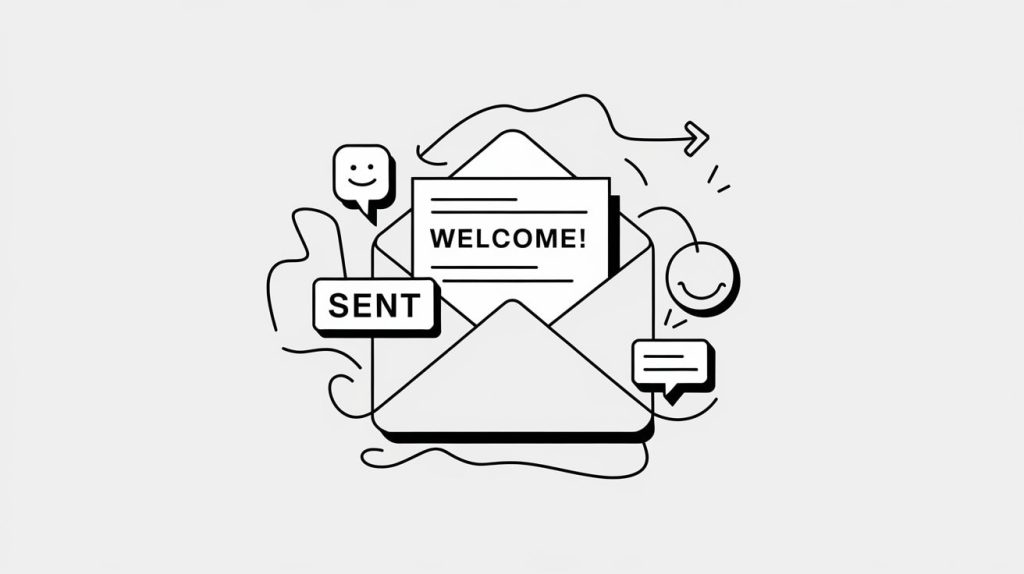
The landscape of bulk email marketing services continues to evolve, with providers offering a range of tools to help businesses reach their audience efficiently. Below are some of the top bulk email service providers for 2025, along with their standout features.
Mailchimp
Mailchimp remains a popular choice for email marketing campaigns, known for its customizable email templates and intuitive drag-and-drop editor. It’s ideal for beginners but comes with a higher price tag for larger lists or advanced features like segmentation and analytics.
Brevo
Formerly Sendinblue, Brevo is an all-in-one platform that combines email marketing with SMS marketing and a lightweight CRM. It’s budget-friendly with a free plan offering up to 300 daily emails, making it a great option for small businesses.
HubSpot
HubSpot integrates email marketing with its robust CRM, offering tools for advanced segmentation, automation, and in-depth analytics. It’s a powerful platform, particularly for businesses already using HubSpot’s suite of products, but the pricing can escalate quickly.
SendGrid
Known for its strong focus on email deliverability, SendGrid is a go-to for developers and marketers alike. It offers robust APIs, real-time analytics, and reliable delivery, though it has a steeper learning curve for those unfamiliar with its technical features.
GetResponse
GetResponse stands out as an email marketing platform offering landing page builders, webinar tools, and advanced automation workflows. Its free plan supports up to 2,500 emails, making it a versatile choice for growing businesses.
Mailtrap
Mailtrap is a modern email platform designed for digital products and SaaS companies, enabling them to send both transactional and bulk emails at scale. It offers a flexible Email API and SMTP for developers, along with a campaign builder tailored for marketers.
Why Woodpecker Is the Smarter Alternative for Cold Outreach
Woodpecker isn’t your average bulk email service provider. It’s built to excel where traditional platforms fall short – crafting personalized, one-to-one cold email campaigns at scale. Instead of relying on generic email marketing campaigns, Woodpecker enables businesses to focus on meaningful connections that drive real results.
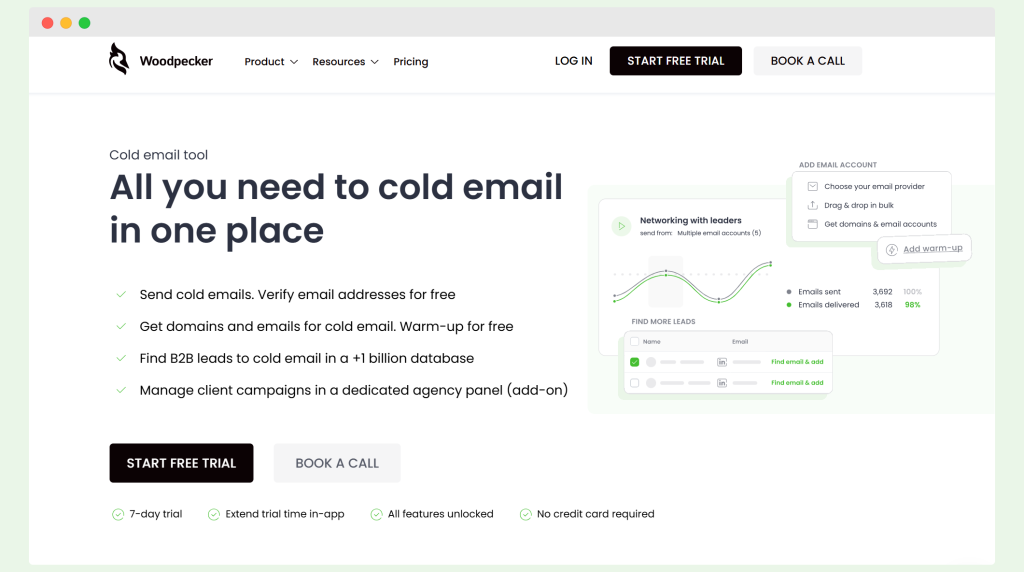
Here’s why Woodpecker is a game-changer for businesses looking to optimize their outreach strategy:
- Targeted Campaigns: Avoid mass, impersonal emails. Woodpecker’s tools, like dynamic fields and condition-based triggers, make tailored messaging easy.
- Deliverability Focus: With features like free email verification, warm-up, and adaptive sending, your emails land in inboxes, not spam folders.
- End-to-End Workflow: From domain setup and warm-up to campaign execution and performance tracking, Woodpecker covers the entire process seamlessly.
- Easy for Teams and Agencies: With agency panels, it simplifies managing multiple client campaigns, making it ideal for marketing teams and agencies.
Woodpecker also ensures your sender reputation stays intact through advanced features like inbox rotation and monitoring, so your campaigns not only reach your audience but make a lasting impact.
While other platforms specialize in broad email marketing tools, Woodpecker focuses on the art of precision-driven outreach. It’s not just a bulk email provider—it’s your partner in building tailored, impactful relationships that convert.
If your 2025 goal is to move beyond generic outreach and send emails that truly resonate, Woodpecker is the ultimate tool to make it happen.
Step-by-Step Guide to Successful Email Campaigns
Creating a successful email campaign requires precision, strategy, and the right tools. Each step below is designed to optimize your efforts, from preparation to execution and analysis. Let’s dive deeper into what makes each stage effective.
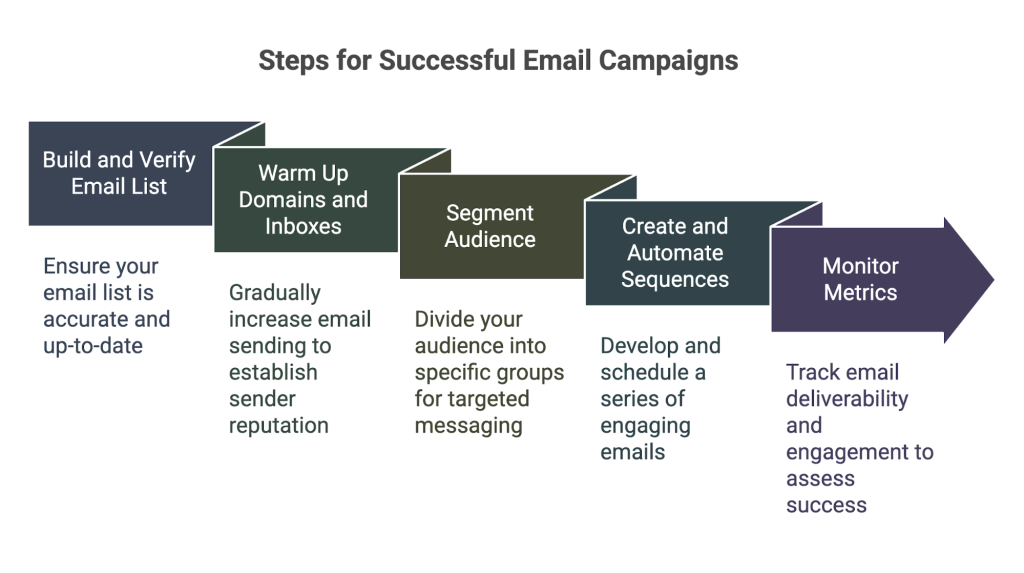
Step 1: Build and Verify Your Email List
A clean and verified email list is the foundation of any campaign. Sending to invalid or outdated addresses not only wastes resources but can also harm your email deliverability. Start by consolidating your existing contacts and collecting new leads through signup forms or landing page builders.
Use tools like Woodpecker’s free email verification to ensure every address is valid and safe to contact. Verification reduces bounce rates, protects your sender reputation, and ensures your emails are seen by the right people.
Action List:
- Compile a list of existing leads and contacts from your CRM or past campaigns.
- Use email verification tools to remove invalid or outdated addresses.
- Regularly update your list to maintain accuracy and relevance.
Step 2: Warm Up Domains and Inboxes
Sending bulk emails from a cold domain or inbox can raise red flags with spam filters, leading to poor deliverability. Warming up involves gradually increasing your sending volume over time, building a positive reputation with email providers.
Woodpecker’s automated warm-up feature simplifies this process, allowing you to avoid spam traps and ensure your emails consistently land in inboxes.
Action List:
- Set up a dedicated domain or inbox for email campaigns.
- Use an automated warm-up tool to send small batches of emails over several weeks.
- Monitor sender reputation with tools like SPF, DKIM, and DMARC records to ensure compliance.
Step 3: Segment Your Audience for Personalization
Segmentation helps you divide your audience into smaller, more targeted groups based on criteria such as purchase behavior, demographics, or engagement levels. Tailored messaging makes your emails more relevant, increasing open and click-through rates.
For example, you might create separate segments for new leads, returning customers, and inactive subscribers, each with its own messaging strategy.
Action List:
- Analyze your audience and create segments based on interests, behaviors, or demographics.
- Use a bulk email service provider with advanced segmentation capabilities.
- Develop unique messaging for each segment to improve engagement.
Step 4: Create and Automate Engaging Email Sequences
Email sequences allow you to nurture leads, follow up on inquiries, or send reminders without constant manual effort. Use a drag-and-drop editor and customizable templates to design visually appealing, on-brand emails.
Automate workflows to trigger specific actions, such as sending a welcome email after a signup or a follow-up after a purchase. Automation ensures consistent communication while saving time.
Action List:
- Use a drag-and-drop builder to design emails that match your brand identity.
- Set up automated workflows for common triggers, such as signups or cart abandonments.
- A/B test subject lines and content to optimize engagement.
Step 5: Monitor Deliverability and Engagement Metrics
Once your campaign is live, monitoring its performance is critical. Metrics like open rates, click-through rates, and conversions provide insight into what’s working and what needs adjustment.
Woodpecker offers real-time analytics and custom reports, allowing you to track performance with ease. By analyzing this data, you can refine future campaigns and maximize ROI.
Action List:
- Track metrics such as open rates, click-throughs, and bounce rates using real-time analytics.
- Identify underperforming segments and optimize your strategy accordingly.
- Generate custom reports to present results to stakeholders or team members.
When to Use Bulk Emailing Services and When to Choose Alternatives

Not all email campaigns are created equal, and neither are the tools to execute them. Understanding the right context for bulk emailing services versus alternatives like Woodpecker can ensure your campaigns hit the mark every time.
When to Use Bulk Emailing Services
Bulk emailing services are perfect for scenarios where you need to reach a broad audience with a unified message. They’re designed for high-volume communication and are ideal for:
- Newsletters: Keep subscribers informed about company updates, industry news, and trends.
- Promotions: Announce sales, discounts, or special offers to a wide customer base.
- Announcements: Notify your audience about product launches, events, or organizational changes.
These platforms excel at creating visually appealing emails with customizable email templates and drag-and-drop editors, making it easy to craft campaigns that grab attention. If you’re running an online store, tools like Mailchimp or Brevo allow you to send marketing campaigns to unlimited contacts while tracking performance metrics like opens and clicks.
When to Choose Woodpecker’s Cold Outreach
For businesses focusing on personalized B2B campaigns, lead nurturing, or targeted sales outreach, Woodpecker offers a more tailored approach. Instead of broad messaging, it enables one-to-one communication at scale with tools designed for precision.
Woodpecker stands out for its:
- Personalization: Dynamic fields and condition-based triggers ensure every email feels relevant.
- Deliverability tools: Features like free email verification, warm-up, and inbox rotation keep emails out of spam folders.
- Workflow management: Its intuitive design supports multi-step campaigns, making it easy to nurture leads over time.
This makes Woodpecker the go-to solution for businesses targeting specific decision-makers, developing long-term relationships, or managing complex sales cycles.
Conclusion: Finding the Right Tool for Your Email Strategy
Choosing the right tool for your email campaigns isn’t just about convenience—it’s about ensuring your messages align with your goals and resonate with your audience. If your focus is on high-volume communication, bulk email services are excellent for generic campaigns like newsletters, promotions, and announcements. Their drag and drop email builders and user-friendly interfaces make crafting visually appealing messages simple and efficient.
For campaigns that demand a personal touch, Woodpecker offers the perfect solution. Designed for personalized outreach, it excels in B2B scenarios where building relationships and nurturing leads matter most. With key features like free email verification, inbox rotation, and dynamic condition-based triggers, Woodpecker takes cold email campaigns to the next level.
Stop wasting time with the ineffective “spray-and-pray” approach. Explore tools like Woodpecker to create smarter, more effective campaigns that connect with your audience and deliver results. It’s time to transform your email strategy—one targeted message at a time.
FAQ
Is there a free bulk email marketing service?
Yes, many bulk email service providers offer free plans to help you get started. Platforms like Mailchimp, Brevo, and SendGrid provide free plans with features such as drag and drop email builders, customizable templates, and basic analytics. However, free plans often come with limitations on the number of emails you can send or the features you can access. For example, Brevo offers up to 300 emails per day for free, while Mailchimp allows 1,000 emails per month.
What is the best mass emailing service for bulk email campaign?
The best mass emailing service depends on your needs. For broad email marketing campaigns, platforms like Mailchimp and HubSpot are popular due to their user-friendly interfaces and robust features like email automation and advanced segmentation. If you need something tailored for cold email campaigns, Woodpecker is a standout option. Its key features, such as inbox rotation and email verification, make it ideal for B2B outreach and personalized communication.
How to send 10,000 emails at once for free?
Sending 10,000 emails for free can be challenging, as most free bulk email services impose limits. For instance, Sender offers up to 15,000 emails per month on its free plan, but it limits you to 2,500 subscribers. Platforms like SendPulse and Mailjet also provide generous free tiers, but the limits on daily or monthly email volume vary. To send 10,000 emails efficiently, consider splitting your campaign across multiple days or investing in a low-cost plan with a bulk email provider.
What is the cheapest way to send bulk emails?
The cheapest way to send bulk emails is by using platforms with affordable pricing and features that match your needs. Services like Brevo start at $9/month, and Sender offers plans starting at $15/month, both providing excellent value with tools like drag and drop email editors, segmentation, and analytics. For businesses with limited budgets, exploring free plans or combining a free bulk email service with a low-tier subscription plan can help reduce costs while maintaining quality and deliverability.

